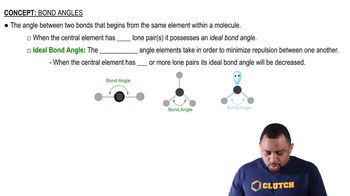Here are the essential concepts you must grasp in order to answer the question correctly.
Electron-Dot Structures
Electron-dot structures, also known as Lewis structures, represent the valence electrons of atoms within a molecule. They illustrate how atoms are bonded together and can help predict molecular geometry. In the case of CF3SF5, the structure will show the arrangement of carbon, fluorine, and sulfur atoms, along with their bonding and lone pairs of electrons.
Recommended video:
Lewis Dot Structures: Ions
Molecular Geometry and Bond Angles
Molecular geometry refers to the three-dimensional arrangement of atoms in a molecule, which influences its physical and chemical properties. The bond angles are determined by the repulsion between electron pairs around a central atom. For CF3SF5, understanding the geometry around carbon and sulfur will help predict the bond angles based on their hybridization and the number of surrounding atoms.
Recommended video:
Hybridization
Hybridization is the concept of mixing atomic orbitals to form new hybrid orbitals that can accommodate bonding. In CF3SF5, carbon undergoes sp3 hybridization due to its four bonding pairs, while sulfur may exhibit sp3d hybridization due to its five bonding pairs. This hybridization affects the molecular shape and the angles between bonds, which are crucial for predicting the structure of the molecule.
Recommended video:




